
AI in Education Technology: Transforming Learning in 2025
Artificial Intelligence (AI) is revolutionizing the U.S. education sector, reshaping how students learn, teachers instruct, and institutions operate. In 2025, AI in education technology is not just a trend—it’s a fundamental shift driving personalized learning, administrative efficiency, and equitable access to quality education. This comprehensive guide explores the latest advancements, top AI tools, benefits, challenges, and the future of AI in education technology.
What Is AI in Education Technology?
AI in education technology refers to the integration of artificial intelligence systems—such as machine learning, natural language processing, and data analytics—into educational platforms, tools, and processes. These technologies enable adaptive learning, automate administrative tasks, and provide data-driven insights to enhance teaching and learning outcomes.
TIP: AI-powered education technology adapts to individual student needs, making learning more engaging and effective! 🎓
How AI Is Reshaping U.S. Classrooms in 2025
Personalized Learning Experiences
AI-driven platforms analyze student performance and learning styles, delivering customized content and recommendations. This personalization helps students master concepts at their own pace, boosting engagement and retention.
Intelligent Tutoring Systems
AI tutors provide instant feedback, answer questions, and guide students through complex topics—offering 24/7 support beyond traditional classroom hours.
Automated Grading and Assessment
AI automates grading for multiple-choice, short-answer, and even essay questions, saving teachers valuable time and ensuring consistent, unbiased evaluation.
Predictive Analytics for Student Success
By analyzing attendance, participation, and performance data, AI predicts which students may need extra support, enabling timely interventions.
Enhanced Accessibility
AI-powered tools like speech-to-text, real-time translation, and adaptive interfaces make learning more accessible for students with disabilities or language barriers.
Top 10 AI Tools in Education Technology for 2025
Here are the leading AI-powered education technology tools making waves in U.S. schools and universities this year:
- Knewton Alta
- Socratic by Google
- Duolingo
- Carnegie Learning
- Quizlet AI
- Gradescope
- Century Tech
- DreamBox Learning
- Coursera AI
- Otter.ai
Side-by-Side Comparison Table
| Rank | Tool Name | Main Function | Best For | AI Feature Highlight |
|---|---|---|---|---|
| 1 | Knewton Alta | Adaptive learning platform | Higher Ed, K-12 | Personalized content paths |
| 2 | Socratic by Google | Homework help, Q&A | K-12, College | Natural language processing |
| 3 | Duolingo | Language learning | All ages | Adaptive exercises |
| 4 | Carnegie Learning | Math instruction | K-12 | AI-driven tutoring |
| 5 | Quizlet AI | Study tools, flashcards | K-12, College | Smart practice suggestions |
| 6 | Gradescope | Grading automation | Higher Ed | AI-assisted grading |
| 7 | Century Tech | Personalized learning | K-12 | Real-time analytics |
| 8 | DreamBox Learning | Math learning | K-8 | Adaptive learning engine |
| 9 | Coursera AI | Online courses | Higher Ed, Professionals | AI course recommendations |
| 10 | Otter.ai | Transcription, note-taking | All ages | Real-time speech-to-text |
Benefits of AI in Education Technology
1. Personalized Learning Paths 📚
AI customizes lessons and resources to fit each student’s strengths, weaknesses, and interests.
2. Improved Teacher Efficiency 🕒
Automating administrative tasks allows educators to focus more on teaching and mentoring.
3. Data-Driven Insights 📊
AI analyzes vast amounts of educational data, helping schools make informed decisions about curriculum and interventions.
4. Enhanced Student Engagement 🎮
Gamified AI platforms and interactive content keep students motivated and involved.
5. Greater Accessibility 🌍
AI tools break down barriers for students with disabilities and those learning English as a second language.
Challenges and Considerations for AI in Education Technology
Data Privacy and Security
Handling sensitive student data requires robust security measures and compliance with regulations like FERPA.
Equity and Access
Not all students have equal access to AI-powered devices or high-speed internet, potentially widening the digital divide.
Teacher Training
Educators need ongoing professional development to effectively integrate AI tools into their teaching practices.
Algorithmic Bias
AI systems can inadvertently reinforce biases present in their training data, impacting fairness in education.
TIP: Schools should regularly audit AI tools for bias and ensure transparency in how decisions are made. 🛡️
The Future of AI in Education Technology: Trends to Watch
- AI-Driven Career Pathways: Platforms will increasingly guide students toward careers based on their skills and interests.
- Virtual Reality (VR) + AI: Immersive, adaptive learning environments will become more common.
- Lifelong Learning: AI will support continuous education for adults, helping them reskill for the evolving job market.
- Collaborative AI: Tools will foster teamwork and communication, not just individual learning.
Conclusion: The Impact and Promise of AI in Education Technology
AI in education technology is fundamentally transforming the U.S. learning landscape in 2025. From personalized learning and intelligent tutoring to automated grading and predictive analytics, AI empowers students, teachers, and administrators alike. While challenges like data privacy, equity, and bias remain, the benefits—greater engagement, efficiency, and accessibility—are undeniable.
As AI continues to evolve, its role in education will only grow, offering new opportunities for innovation and inclusion. By embracing AI thoughtfully and ethically, U.S. schools and universities can ensure that every learner has the tools and support needed to succeed in a rapidly changing world. The future of education is intelligent, adaptive, and brighter than ever. 🚀